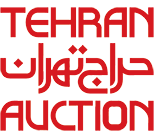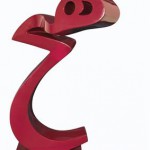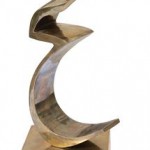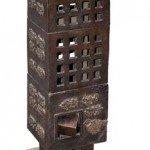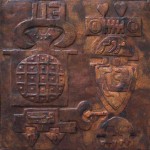Parviz Tanavoli is, without doubt, one of the most prominent influential Iranian artists of the last century. This trend-setting figure of the Iranian contemporary art who was both a sculptor and a painter during the early years of his artistic career, achieved growing fame as an avant-garde sculptor with a style of his own. Despite all difficulties, Tanavoli won national prestige and international reputation and grew in fame when he set a historic record for the sale of his sculpture.
In addition to Tanavoli’s Heech sculptures that are unique, The Wall collection is also considered a great and formidable achievement of the sculptor. Not only did these works set the highest record for Tanavoli but they set a record for the art market of the entire Middle East. They are, indeed, the artist’s tribute to inscriptions on the walls of Iran’s ancient monuments. In their minimalized, abstract forms, these walls are monumental works that celebrate the ancient civilization of the west and south of Iran. They are also reminders of the Egyptian, Sumerian, or Sassanid relief works. From an aesthetic point of view, The Wall is a pure bronze mass, like minimalist cubes, with compressed illegible writings in Persian, Arabic, or ancient calligraphic forms. The Wall is thus a minimalist form compared to Tanavoli’s other works, comprising two structural elements: a Platonic geometric mass similar to architectural foundations, and an illegible calligraphic element with a regular consistent fabric.
Walls are one of the most ancient architectural elements that have assumed various forms throughout history. In a classic sense, walls are expressive surfaces with a decorative and aesthetic significance beyond a separating fence. In our collective memory, walls remind us of the dome of mosques or any other sacred space when they are decorated with inscriptions. Tanavoli’s walls are, therefore, turned into symbols in our minds, signifying Iranian, or global, ancient wisdom and cultural heritage. The simplest, purest work of the collection is the bronze Oh Persepolis(1974), a large highly minimalized standing cube. Even though this fine monolithic sculpture is noticeably similar to the work of American minimalist sculptors of the 1960s, it brings to mind an Oriental treasure trove because of the calligraphic work as well as allusion to historic inscriptions such as the one on the Cyrus Cylinder.
In the work on display, the wall with inscriptions is combined with another element of Tanavoli’s work, i.e. the padlock. His padlocks appear on the figure of Farhad, the poet, nightingale, cage, and even Heech figures, sometimes enclosing a wall, such as this one, from top to bottom. They are symbols of Persian gnostic literature, clearly alluding to reclusion and denial of affection and freedom. On the other hand, the brightness of the glossy surface of this part has created a contrast with the coarse surface where inscriptions appear, highlighting the antiquity of the concept of walls and padlocks.
The works of Tanavoli have been shown in numerous exhibitions. The Tehran Museum of Contemporary Art organized a large-scale exhibition of his works in 2003, on his return to Iran after years of living away from his homeland. He has works in major collections around the world, including the Museum of Modern Art (New York), the British Museum, the Metropolitan Museum (New York), the Ludwig Aachen Museum, the Museum of Modern Art (Vienna), and the Tehran Museum of Contemporary Art. This has secured a special place for him among Iranian artists.
In general, perhaps Tanavoli’s major legacy is his concept of sculpture rather than his invaluable works. He supersedes his fellow sculptors as a firm modernist, while an Iranian identity was most evident in his work compared to the sculptors of his generation. He adeptly combined elements of traditional and folk art, elements of ritual and Shiite culture, as well as Persian gnostic literature with modern approaches in sculpture to give life to a fluid experience, half way between a local Modernism and Iranian Post-Modernism. No matter what direction Iranian sculpture will take in the future, Parviz Tanavoli will, no doubt, to be known as a leader.
A sculpture from Tanavoli’s The Wall collection, titled Persepolis, was sold for over $2.8m at the Christie’s Auction in 2008, setting a record in the art market of the Middle East.
